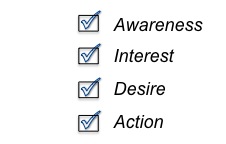By Deb Calvert, President, People First Productivity Solutions
Every sales training program and book about increasing sales offers a sales process. These step-by-step processes help sellers to orient themselves and move through a logical progression from opening the sale all the way through to closing the sale.
Having a sales process is a good practice.
Knowing and following your buyer’s process is an even better practice.
The buyer’s process is simple, and it’s universal. Every time you plan to buy something, you follow exactly this same process. It applies when you’re making an impulse purchase like a pack of gum at the checkout counter. It also applies, unchanged, when you make a major purchase that takes months of research and planning.
The buyer’s process works like this:
Before anyone ever buys anything, they must first have an awareness that it exists. Further, the buyer needs to be interested in the item. If that interest builds into desire, a buyer may then (and only then!) take action to acquire the item.
Recapping, the buyer’s process is this:

Like it or not, no sales process will ever operate independently of the buyer’s process. Ideally, the sales process should track right alongside the buyer’s process. A savvy seller will be tuned in to gauge where the buyer is and will recognize the early signs of interest. In response to the buyer’s interest, the smart seller will help build and magnify desire by showcasing relevant and personalized benefits. And, when the time is right, the seller will advance to a close at the moment when the buyer is ready to take action.
Selling shouldn't be much more complicated than that. Unfortunately, it often is. One thing that may complicate and prolong some sales interaction is a laborious sales process that gets in the way of a seller tracking through the buyer’s process.
A quick online search of “sales process” yielded 281,000,000 results with over 500 images illustrating a variety of sales processes. Some of those processes have over 20 steps! I’m not sure it’s reasonable to expect a seller to remember and execute all 20 steps in order. It’s certainly not reasonable to expect a buyer to tolerate extra steps. All the buyer cares about is awareness – interest – desire – action.
Sellers don’t much like to follow even simple sales process. That’s why so many sellers race ahead to try and close a sale prematurely. It’s bad enough to be out of sequence with your own sales process, but it’s fatal to be out of synch with your buyer’s process.
The best case scenario is when the buyer and seller processes dovetail. The seller knows how to follow the buyer’s process because the sales process is aligned. When the seller opens the sale, he or she uses language and techniques that give the buyer awareness and move the buyer toward interest.
Next, the seller asks questions and works to better understand the buyer’s needs. Thought-provoking questions clarify the buyer’s interest and reveal what is of personal value to the buyer. The information gathered provides the seller with the relevant benefits and best-fit solution for this particular buyer. At this point, the seller makes a proposal, telling a story that weaves in the buyer’s interest and needs and linking those to a compelling solution that offers high-value benefits. This, of course, heightens the buyer’s desire.
The seller then moves alongside the buyer to work out any obstacles that may prevent the buyer from taking action. Objections are invalidated, terms are negotiated, and the buying signals are becoming stronger. Clearly, the buyer is ready to take action. So the seller closes.
In order for it to work out this way, the seller has to be willing to let the buyer lead the way. While the seller may occasionally steer the direction of the conversation, the seller cannot force or push the buyer to advance to the next level of the process. That shuts buyers down faster than anything. Is it worth the wait? You bet! Buyers who sell themselves are more committed and less likely to experience buyer’s remorse than those who felt rushed or coerced in any way.
The seller also has to be tuned in to the buyer’s subtle signals in order for this to work as smoothly as it’s been described here. For many sellers, that would require a muzzle because it’s hard to talk and listen at the same time. This is why asking questions is far more powerful than long-winded presentations. The buyer will respond to questions with personalized answers. Strong questions will help the buyer visualize buying and using the product. A sales pitch, generic by its very nature, simply can’t compete when it comes to building desire and compelling buyer action.
Work with this and see what happens. When you empathize and align with your buyers, you may be surprised at how simple selling can be.
Please join the conversation in 'This Week's Discussion'. What is your sales process? Is it working?
Written by Deb Calvert,
Sales Expert for ManagingAmericans.com & President, People First Productivity Solutions.
Ask our Expert Panel a question in Sales Ask an Expert Forum.
Here are some related articles you may be interested in:
Learn to focus your efforts on opening doors for productive customer relationships.
Now That’s Old School Selling!
Are your marketing dollars being wasted?
Four Ways to Transition Business Development into Sales Revenue
At ManagingAmericans.com we encourage members to go in and out of our communities to learn about different areas of the business; how to work together, solve problems and improve skills. Each community details expectations, challenges, success tips, training programs and useful resources. Growing your knowledge base and learning about all areas of business can help you navigate towards success in your career.